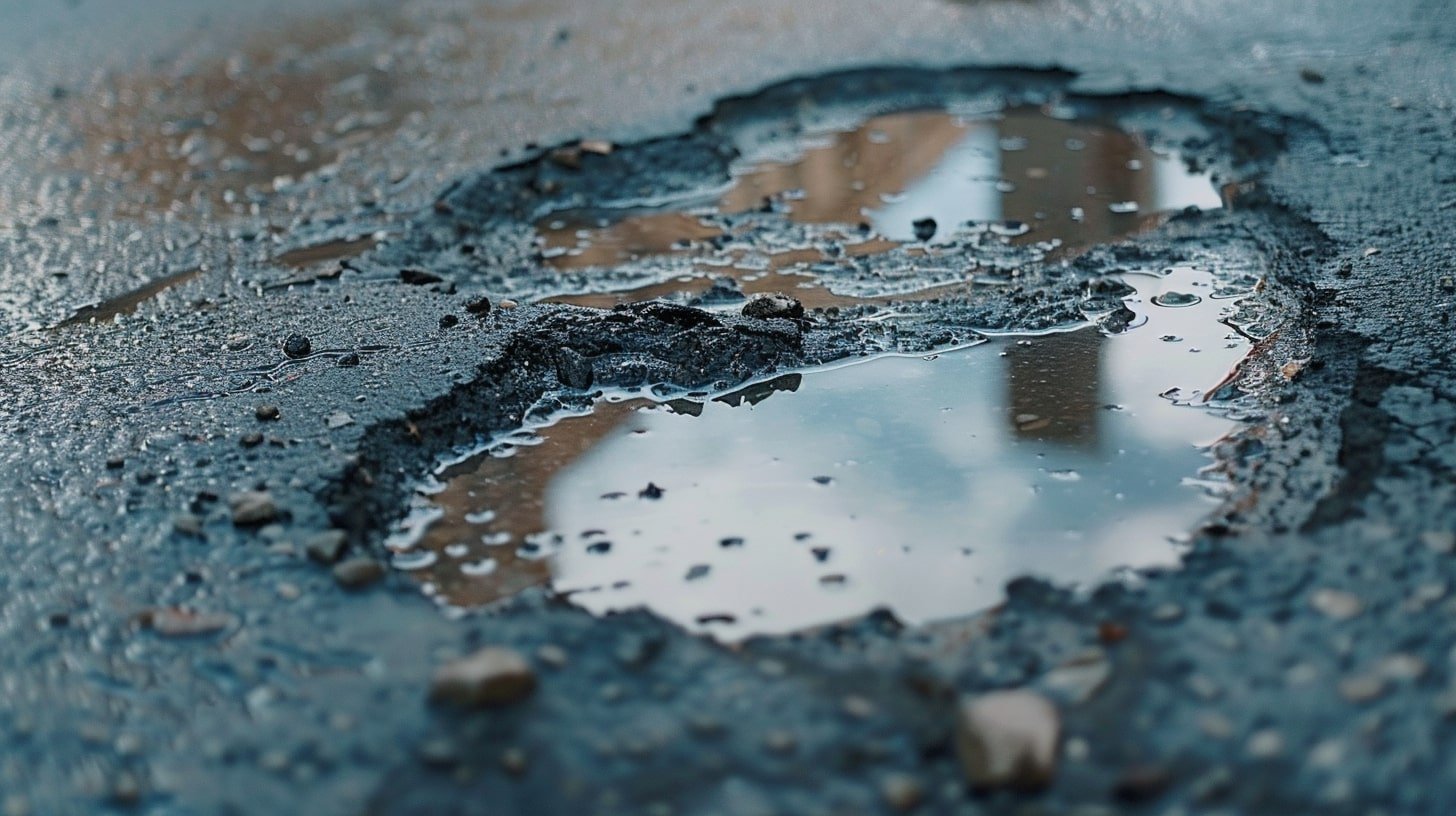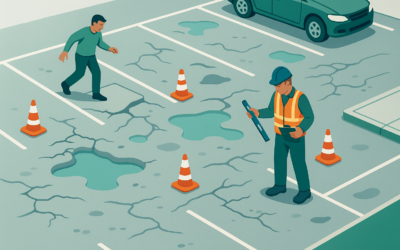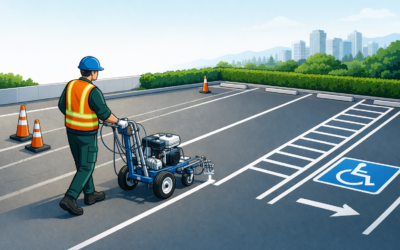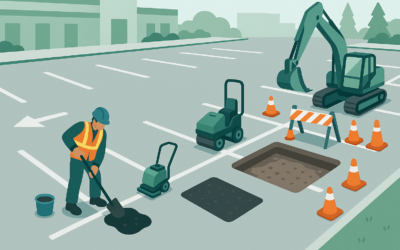Potholes in concrete surfaces are not just an eyesore; they’re a hazard that can damage vehicles and pose risks to pedestrians. Understanding how to repair these imperfections not only enhances safety but also preserves the value of the property. This article offers a comprehensive guide on the efficient and effective repair of potholes, ensuring longevity and durability of concrete surfaces. From assessing damage to applying the perfect mixture, every step is covered to equip you with the necessary skills to tackle this common problem.
Table of Contents
Understanding Potholes in Concrete
What Causes Potholes in Concrete Surfaces?
Potholes in concrete surfaces typically occur due to weathering, water infiltration, and the constant stress of traffic. When water seeps into existing cracks or joints in the concrete, it can freeze and expand, widening the cracks and ultimately leading to chunks of concrete breaking away. Environmental factors such as temperature fluctuations and chemical spills can also deteriorate the integrity of concrete, hastening the formation of potholes.
Assessing the Damage
Before attempting any repair, it’s crucial to assess the extent of damage. Not all potholes are created equal; their severity can range from shallow depressions to deep cavities. Assessing the size, depth, and position of the pothole helps determine the appropriate repair method. It’s important to consider if there is underlying structural damage that might require professional intervention. If you’re unsure, it might be beneficial to consult a structural engineer or a professional repair service to evaluate the pothole.
Understanding these factors paves the way for a thorough preparation of the repair strategy, ensuring a durable fix that can withstand the rigours of weather and vehicular load. For homeowners, this knowledge empowers them to make informed decisions about tackling the repair themselves or calling in a professional.
Tools and Materials Needed for Pothole Repair
Necessary Tools
Preparing for a pothole repair begins with the right set of tools. Essential items include:
- Chisel or heavy-duty hammer for debris removal.
- Sturdy broom or vacuum cleaner for clearing out loose particles.
- Trowel or float for applying and smoothing the filler material.
- Mixing paddle attached to a powerful drill for preparing the concrete mix.
- Wheelbarrow or large bucket for mixing materials.
Having these tools at hand not only makes the job smoother but also ensures a more professional finish to the repair work.
Choosing the Right Repair Materials
Selecting the correct materials is crucial in ensuring the repair lasts. Here are the options:
- Concrete Mix: Quick-setting concrete mixes are preferable as they set rapidly and can bear traffic within hours. Look for weather-resistant types that cater to the climactic conditions of your area.
- Filler and Sealant: Polymeric sand or asphalt patch can be used as filler. Sealants protect the repair from moisture and chemical spills, crucial for prolonging the life of the concrete.
Preparing the Area for Repair
Cleaning the Pothole
Thorough preparation of the pothole is essential for a successful repair. Begin by removing any loose debris, dirt, or water from the pothole using a sturdy broom or a vacuum cleaner designed for heavy-duty outdoor use. It’s crucial that the area to be patched is clean and dry to ensure the repair materials adhere properly. Here’s how to go about it:
- Chisel away any unstable or loose concrete pieces within and around the edges of the pothole.
- Brush out all debris using a heavy-duty brush or broom.
- If available, use a blower to remove finer particles.
- Ensure the pothole is completely dry. If necessary, use a heat gun or leave it to air dry in good weather conditions.
Ensuring Safety While Working
Safety should never be compromised. Whether you’re a DIY enthusiast or a professional, appropriate safety measures are imperative:
- Personal Protective Equipment (PPE): Always wear safety glasses, sturdy gloves, and a dust mask to protect against flying particles and dust. A hard hat is recommended if you’re working in an area with potential falling debris.
- Area Safety: If the repair site is in a traffic zone, use traffic cones and warning signs to alert people and vehicles of the work in progress.
- Tool Safety: Ensure all tools are in good condition, without defects. Use electrical tools that are grounded, and never operate in wet conditions.
Adhering to these safety protocols helps prevent accidents and ensures a smooth and uninterrupted repair process.
The Step-by-Step Repair Process
Mixing Concrete for Pothole Repair
The choice of concrete and its preparation is the cornerstone of a durable repair. Use a high-quality quick-setting concrete mix suited for outdoor use. Follow these steps for mixing:
- Measure the water each bag of mix requires carefully; too much can weaken the concrete.
- Pour the required amount of water into your mixing container first.
- Add concrete mix slowly into the water while stirring with a power drill and mixing paddle. This method helps avoid lumps.
- Continue to mix until you achieve a uniform, workable consistency—similar to peanut butter.
Filling the Pothole
Once the mix is ready, filling the pothole correctly is critical for ensuring the patch holds:
- Fill the pothole with the mixed concrete, starting from one corner and pushing across to eliminate air pockets.
- Use a trowel to smooth the concrete, ensuring it’s level with the surrounding surface.
- For larger potholes, use a piece of lumber to screed the surface.
Curing the Concrete
Curing is the final and one of the crucial steps in concrete repair. Proper curing helps increase the strength and durability of the set concrete. Cover the filled pothole with plastic sheeting or a curing blanket to keep it moist and maintain an even curing temperature. Allow at least 24 hours before allowing light traffic, and up to a week for heavy vehicles.
Understanding and executing these steps accurately will ensure your repaired pothole stands the test of time and usage.
Preventing Future Potholes
Maintenance Tips for Concrete Surfaces
To extend the life of concrete surfaces and prevent the formation of new potholes, regular maintenance is crucial. Implementing the following maintenance practices can significantly mitigate potential damage:
- Regular Cleaning: Keep the surface free of debris and dirt that can retain moisture and contribute to the breakdown of the concrete.
- Sealant Application: Apply a quality sealant every few years to help protect the concrete from moisture penetration, chemicals, and wear.
- Crack Monitoring and Filling: Inspect the surface regularly for new cracks and fill them promptly to prevent water ingress and subsequent damage.
When to Schedule Professional Inspections
While routine self-maintenance can significantly aid in prolonging the life of concrete surfaces, professional inspections are vital in identifying deeper issues that might not be evident to the untrained eye. Consider scheduling professional inspections:
- After Severe Weather Events: Heavy rains, floods, or freeze-thaw cycles can severely impact concrete integrity.
- Every Few Years: To ensure that any underlying problems are caught early and managed before significant damage occurs.
- When Uncertain: If you observe signs of deterioration that you’re not equipped to assess, seeking professional advice can save extensive costs and effort in the long run.
Professional assessments can provide peace of mind and prevent costly repairs by catching issues early.
Conclusion
This guide has explored various aspects of repairing potholes in concrete surfaces, from understanding the causes to walking through the step-by-step repair process. With the right tools, materials, and techniques, you can effectively address potholes, enhancing both the appearance and functionality of your concrete surfaces. Remember, prevention through regular maintenance and inspections is key to avoiding significant problems in the future. Whether you’re a DIY enthusiast or prefer to rely on professional help, being proactive is the best approach to managing concrete surfaces.
FAQs
- What is the best time of year to repair concrete potholes? The best time is during dry, moderate weather conditions—typically late spring through early fall. This allows the repair materials to cure correctly and adhere well.
- Can all types of concrete potholes be repaired with a DIY approach? Smaller potholes can generally be fixed using DIY methods. Larger or structurally significant damages should be evaluated and repaired by professionals.
- How long does a typical concrete pothole repair last? With proper technique and materials, a pothole repair can last several years. Durability depends significantly on the environment and the traffic the area is subjected to.
- Are there environmentally friendly materials for concrete repairs? Yes, there are sustainable concrete mixes and eco-friendly sealants available that minimize environmental impact. These products provide a durable, less toxic alternative to traditional materials.
- What are the legal implications of improperly repaired potholes on private property? Homeowners can be held liable for accidents caused by negligence in maintaining safe conditions on their property. This includes failing to repair potholes adequately.







